
Customizing a Massage According to Ayurvedic Principles
Once you have determined a recipient’s main Ayurvedic dosha, you are ready to design your Thai Yoga Massage according to that client’s individual needs. The first key to integrating Ayurveda into a Thai Yoga Massage practice are the three main massage approaches that correspond to each doshic type. Those are the focus of this chapter.
The everyday practices of Ayurveda are deeply rooted in profound concepts of Vedic philosophy. This is especially apparent in the classification of the massage approaches for each dosha.
According to Vedic philosophy, there are three forces of nature within the universe that are present within all matter and are responsible for all creation. As we discussed in chapter 1, these three subtle qualities, or gunas, are known in Sanskrit as sattva, rajas, and tamas. Sattva, generally understood to be the most subtle of the three, is defined as harmony, light, virtue, and intelligence. Rajas is a vital active force that relates to activity, movement, change, and excitability. Our present-day society, characterized by constant movement and activity, is ruled by rajas. The final guna of tamas is considered to be the most gross or material of the three and is associated with heaviness, darkness, and inertia.
Within the practice of Thai Yoga Therapy, the main massage techniques are defined in relationship to these three forces of nature. While one’s doshic body type remains the same throughout his or her life, the gunas that determine a person’s mental nature are transitory. So, regardless of body type, each person has the same ability to evolve and cultivate the sattvic guna in their life. This, in fact, is the underlying aim of Ayurveda and Thai Yoga Therapy—to raise the sattvic nature in ourselves and those around us. As we help ourselves and our clients to achieve doshic balance, we create openings for greater harmony, light, and peace.
MASSAGE APPROACHES AND THE GUNAS
The key to understanding the appropriate guna, or energetic force, to apply to a given doshic body type lies in the fundamentals of Ayurvedic pulse diagnosis.
In the Ayurvedic pulse-diagnosis system, the rhythm of energy flow for each dosha is likened to distinctive qualities of a specific animal. The vata pulse is quick like a snake and slithers around, creating a weak, erratic pulse that is hard to identify. The pitta pulse is strong and rapid like a frog and tends to bound with force and rigor, making it the easiest to recognize. The kapha pulse tends to be slow and graceful like a swan, with profound vibrations that are often hidden deep beneath the thick layers of the kapha skin.
The best way to remember the appropriate palpatory approach for each dosha is to keep a visual image of the animal analogies in mind, along with the Ayurvedic rule of thumb that opposites heal each other. The fast, slithering vata snake is balanced out by a slow, steady pace with the least amount of pressure and long pauses—a sattvic approach. The robust and intense pitta frog requires a steady pace with moderate pressure and pauses—a rajasic approach. And finally, the slow and graceful kapha swan benefits from a faster pace with strong pressure and short pauses—a tamasic approach.
The harmonizing quality of the sattvic approach is most suitable for vata types, who tend to be sensitive in nature and can be overwhelmed by too much stimulation or heavy pressure. The sattvic massage approach is characterized by a light, gentle touch that is done at a slow and easy pace. Of the three approaches, this one involves the least amount of pressure; it is most suited to vata individuals, who tend to be more sensitive to pain and have more delicate bone structures. Although a long, gentle hold may be appropriate in some instances to ground vatas, it should never cause them excessive strain or discomfort. It may be tempting to twist your thin, flexible vata client into a series of challenging postures, but this will actually do her more harm than good. A slow, even pace with frequent repetitions is more appropriate.
The mild, harmonizing sattvic approach balances out vata’s tendency toward erratic energy flow, anxiety, stress, and nervous disorders. A safe, pleasant, and nourishing environment can be created with the use of serene music, candles, and a generous amount of plush pillows and blankets. As vata individuals tend to chill easily, make sure that the massage room is at a warm, comfortable temperature.
The best time to massage a vata person is at dawn or dusk, when vata tends to be the highest and most prone to imbalance. In Thai Yoga Massage, the use of therapeutic oils can cause a slippery grip and leave stains on clothing, mats, and pillows. However, it is possible to integrate the use of oil at the end of a massage by applying small amounts to the hands, feet, face, areas of strain, or specific marma points that can be easily accessed without undressing. Use a base oil that corresponds to one’s dosha, adding a few drops of essential oil as appropriate for aromatherapy. Sesame oil is a favorite in all forms of Ayurvedic treatment and is especially good for vata types because of its warming, heavy, and pacifying qualities. Warming, earthy aromas such as cinnamon, patchouli, or sandalwood can help to ground vata individuals.
Rajasic Touch
As the rajas guna is a force of activity, it follows that the rajasic approach to massage involves more energy and movement than the sattvic approach. This massage approach is most appropriate for pitta individuals, who require a moderately active massage to release built-up energy and aggression. While pitta types also need to be cooled and calmed, the slow and sedating sattvic approach will leave them feeling frustrated and wanting more. As a middle way, the rajasic touch uses firm pressure with a steady and flowing pace that calms and restores pitta individuals.
Because pitta types may be easily aggravated by excessive heat, the use of force should be monitored and counterbalanced, with a brief pause as an interlude between the more stimulating postures. In general, avoid long holds in the postures, as this can be heating. The aim should be to work through tensions rather than to break up resistance.
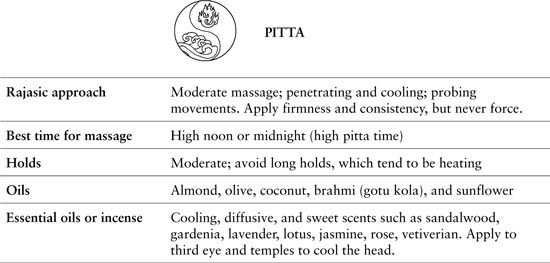
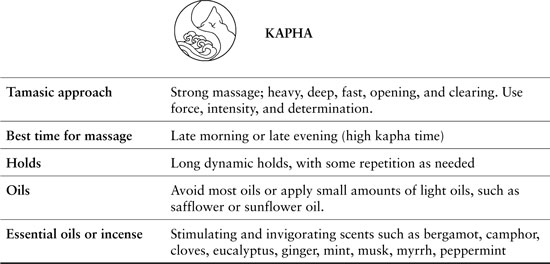
Steady, probing movements can be used to expel toxins, aid digestion, alleviate muscular tension, and relieve knots. During energy-line work, take care not to over-thumb or over-palm your pitta recipients, as these techniques increase circulation and have a heating effect on the body. Also, excessive rubbing may irritate sensitive pitta skin, which is prone to rashes and inflammation.
The best time for a pitta person to receive a massage is at high noon or midnight, when the sun’s effect is most powerful and needs to be relieved. If using oils for localized application, pittas benefit from light or cooling oils such as sunflower, olive, or coconut. Sweet and calming floral scents such as rose and lavender, or the cooling scent of sandalwood, are also recommended.
Tamasic Touch
The quality of tamas is characterized by heaviness and solidity. The tamasic massage approach involves the deepest and most rigorous touch techniques. This massage approach is suitable for kaphas, whose thick, oily skin requires the most stimulation.
Kapha individuals benefit from a strong, heavy, and forceful bodywork approach that breaks up stagnation and accumulation. The pacing for this massage is the fastest of all three approaches and involves intensity and determination on the part of the practitioner. The aim is to open up the body and circulate stagnant energy on the physical, mental, and emotional levels. Kaphas may love to receive a soft and soothing massage, but following the Ayurvedic rule of thumb that opposites heal each other, such an approach would only plunge them into a deeper state of slumber. Of the three primary doshic types, kaphas can handle long holds with some exertion—so you can save your most dynamic Thai Yoga Massage moves for them! Of course, this may be difficult if you are a small vata person working on a heavy-framed kapha individual. In these cases remember to follow common sense and never sacrifice your own comfort or safety.
The use of well-paced repetitive movements, such as rotations and stretches, can help to open up the body and get things moving. The best time for massaging your kapha clients is in the late morning or late evening, when this force is strongest in the body.
Finally, because kaphas already tend to have oily skin and hair, it is best to avoid most oils or to apply small amounts of light oils, such as safflower or sunflower. Stimulating, energizing scents that open the nasal passages, such as eucalyptus or mint, benefit kapha individuals and can be applied to the chest and nose in cases of heavy congestion.
Within the Ayurvedic system, each dosha is associated with particular parts of the body where its forces tend to accumulate. In order to deepen the therapeutic quality of a Thai Yoga Massage session, it helps to know the areas of the body at which each doshic type tends to accumulate tension and metabolic waste.
Each type has a main site of accumulation that is located in the gastrointestinal tract, and it is here where undigested food mass, or ama, tends to build up. When ama is allowed to accumulate over an extended period of time, it can overflow and relocate from the gastrointestinal tract into the weakest areas of the body. Disease occurs when ama collects in such weak pockets of the body and becomes irritated or “angered.”
The key to preventing ama buildup is strengthening agni, or the body’s internal digestive fire. The level of agni determines how well an individual absorbs food and discharges the waste products of the body. When agni is sufficient there is no toxic buildup in the body and mind. When agni is insufficient, however, we suffer from improper digestion, dullness, heaviness, stagnation, and cloudiness. Hence, the state of agni is essential to the health of the body within the Ayurvedic system.
Maintaining healthy functioning of the digestive fire is comparable to keeping one’s home furnace running smoothly. Regular maintenance checkups and the use of appropriate fuels ensures a safe fire and the prevention of residue buildup in the furnace. Similarly, the digestive fire of agni is maintained by regular health checkups and a nutritional, lifestyle, and bodywork program that corresponds to one’s predominant dosha. As a preventive treatment, Thai Yoga Therapy helps to increase agni, reduce the buildup of ama, and draw the bodily toxins back to the sites of accumulation. In cases of high ama buildup a more extensive Ayurvedic detoxification known as pancha karma is necessary; this requires the expertise of a qualified Ayurvedic physician.
The fact that the principal site of accumulation for each dosha is located within the digestive system reflects the importance of proper nutrition and digestion within Ayurveda. The main site of accumulation for vata people is the large intestine or colon. Vitiated vata often manifests in the large intestine in the form of constipation, excessive gas, irregular bowel movements, or lower back pain. Other vata-related areas of the body to be aware of while performing a massage include the spine, back muscles, thighs, kidneys, bones, and the hollow cavities of the body, such as the ears and the pelvic bowl. Very often you will find that vata recipients carry tension or have disturbances in these areas, so you may want to draw your healing awareness to these areas during a massage session.
For a pitta person, the main site of accumulation is the small intestines, where the digestive juices act as a fire for the system. Excessively high pitta often expresses itself in the form of irritable bowel syndrome, acid indigestion, heartburn, ulcers, or diarrhea. The subsidiary sites for pitta, and thus other sites to keep in mind during a massage session, include the mid-abdomen, upper hips, liver, spleen, and eyes.
Each dosha manifests more prominently in specific organs and regions of the body.
The main site of accumulation for a kapha recipient is the stomach. Vitiated kapha often expresses itself in the form of weak digestion, low appetite, and nausea. Excessive kapha also accumulates in the lungs and respiratory system in the form of mucus and congestion. Other areas of the body related to kapha include the sinuses, nose, throat, head, joints, pancreas, lymph nodes, and synovial fluid.
According to Ayurveda, all disease begins with ama, identifiable in the Sanskrit word for disease—amaya. It is easiest to flush away ama when it is still located in the respective site of accumulation: the large intestine for vata, the small intestines for pitta, and the stomach for kapha. Ayurveda uses diet, herbs, yoga asanas, steam therapy, and massage to draw the disease from the body and return it to the original site of accumulation. Once the ama has returned to the gastrointestinal tract, customized massage sessions aid to flush the toxins from the site of accumulation and out of the body.
Whether one requires a sattvic, rajasic, or tamasic touch, the practitioner should never apply a massage approach in a formulaic way that overlooks the unique limitations or desires of the client. If a person requests a massage approach that does not Ayurvedically match his or her body type, never force the issue. In these cases it is best to offer a nonintrusive explanation as to why another approach might be suitable, but then leave the decision up to the client. People who are living in a state of imbalance often crave a food or lifestyle that is the opposite of what they need; this applies to their desired massage approach as well. In order for the wisdom of Ayurveda to be truly beneficial, an individual must actively choose his or her own path to self-awareness and healing.
It is important to use common sense when applying any massage approach to avoid injuring yourself or your recipient. Never force a massage approach on a client who specifically requests another style. Appropriate modifications should always be made in cases in which injuries or medical conditions may be aggravated by any of the massage approaches. The elderly and people with fibromyalgia, cancer, AIDS, osteoporosis, or any disease causing frailty should always receive the light and gentle massage of the sattvic approach. (Individuals with a medical condition should always first seek the advice of a physician before receiving a massage.) When beginning a massage session it is recommended to start with a sattvic touch to relax the body before applying a more rigorous approach, even if your client requires a rajasic or tamasic touch.
AN INNER JOURNEY THROUGH THE KOSHA BODIES
While working on the level of the gunas we are providing an individual approach that touches on all of the five yogic kosha bodies. The koshas, extensions of the physical body, have five forms or sheaths. The first is the physical body, the annamaya kosha. The second, the energy body or pranamaya kosha, is a layer of life force just above the skin. Manomaya kosha, the third layer, is the mental body, where thoughts and doubts are experienced. The fourth is the intellectual body, the vijnanamaya kosha, which provides one’s identity and sense of self. The fifth is the anandamaya kosha, the blissful body that allows one to connect with the metaphysical.
Obstruction to the free flow of energy results in an insufficient supply of prana. This can lead to mental, physical, and spiritual imbalances within the kosha bodies, which may manifest in the form of disease, discomfort, or emotional problems.
The five koshas, or “bodies,” constitute a map of therapeutic healing starting at the gross physical body and moving toward the more subtle layers, ultimately leading to our core self: the embodied soul (see table on page 33). This inner journey is representative of the experiences a person undergoes in a lifetime, in a period of reflection, or even during a session of Thai Yoga Massage. Through working with the body we are able to integrate the energetic fields of the five bodies, expanding our energy out to reach the bliss sheath.
During a Thai Yoga Therapy session we begin by working on the physical body, or annamaya kosha, enabling the recipient’s muscles, joints, skin, and bones to relax and align. Physical touch, massage approach, and Thai Yoga Massage postures all catered to the recipient’s doshic type bring awareness to the body, wake up the senses, and channel energy to various parts of the body. The recipient’s breath is deepened, thus enabling a greater awareness of the breathing process and an expansion into the vital essence body of pranamaya kosha. As we will discuss, this expansion is aided by an Ayurvedic understanding of the five forms of prana (the vayus), sen-line work, marma point therapy, and the appropriate breathing techniques for each dosha.
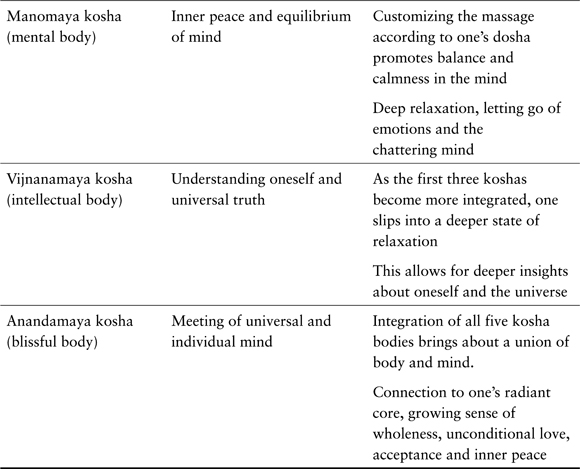
As the body enters into a deeper state of relaxation and awareness, the manomaya kosha, or mental body, becomes calm and still. The ups and downs of the chattering mind are neutralized, allowing for the internal stillness of the mind to emerge, much like the lake bottom comes into view when the waves disappear. The mind is further stabilized with the integration of a customized wellness therapy program that includes a home yoga practice, breathing and meditation techniques, nutritional attention, and supportive lifestyle changes.
With the synchronization of the body, breath, and mind the intuitive knowledge of the intellectual body, or vijnanamaya kosha, unfolds. During this stage of the massage the recipient may have deeper insights about herself and the nature of the universe as a whole. Such awareness leads to a greater sense of freedom and an understanding of the true compassionate self and the interconnectedness of all beings.
Feeling relaxed in the body and mind, the recipient falls into a deep state of peace and tranquility experienced through the anandamaya kosha, the blissful body.
By integrating the knowledge of the kosha bodies into our massage work, we also evolve as practitioners—moving from a physical approach to a more holistic energetic level of healing. The most essential method for understanding energetic healing in Ayurveda involves the concept of the vayus, or five subtle movements within the body. We will now turn our discussion to the vayus, the final tool enabling us to customize a therapeutic approach based on Ayurvedic principles.
THE VAYUS
The ancient Vedic text Chandogya Upandishad refered to subtle energies that flow through the body as “gatekeepers of the celestial world.” These mysterious healing energies are known as the vayus; they control the direction and circulation of life force throughout the body. Vayu, Sanskrit for “wind,” can be imagined as a continuous flow of energy that moves like a current in five principal directions: upward, downward, outward, inward, and centrally. The movement of the five vayus controls and animates the entire body, enabling us to breathe, move, communicate, receive nutrients, and expel wastes. Obstructions or incorrect flow of the vayus can lead to emotional and physical imbalance and, in many cases, disease.
Working with the subtle energies of the vayus is one of the main purposes of Ayurvedic massage. Much like learning a new language, communicating with the vayus requires awareness, sensitivity, and repeated practice. By mastering these energies we can encourage the directional flow of prana to address the specific doshic needs of our clients, significantly increasing the healing benefit of our practice.
Prana vayu
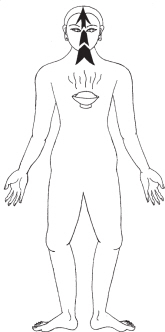
Udana vayu
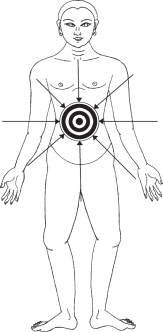
Samana vayu
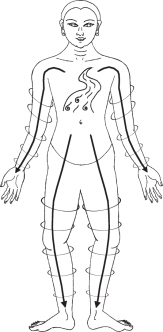
Vyana vayu
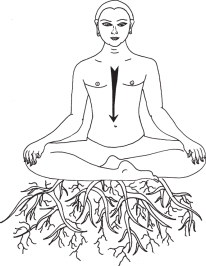
Apana vayu
The first direction of the inner wind is known as prana vayu. It is present in an individual’s cranial cavity and moves downward and inward into the head, throat, heart, and lungs. The prana vayu should not be confused with the general prana, or life force, of the body; it is a subtype of prana. Prana vayu is the most controlling of the five vayus and is responsible for determining a person’s overall health. It governs inhalation and is associated with the recharging of our internal vital energy. Prana vayu is responsible for sensation, feelings, perception, and the circulation of thoughts. It is generally considered to be neutral in temperature. The primary movement of prana vayu is inward.
The second direction of wind flowing in the body is udana vayu. It is centered in the diaphragm and moves upward through the lungs, throat, senses, and brain, all the way up to the crown of the head. Udana vayu governs exhalation and is responsible for coughing, sneezing, speaking, and memory. The upward flow of energy has a heating effect. The primary movement of udana vayu is upward, creating a lifting sensation in the body.
Samana vayu, the third direction of wind in the body, is directly connected to the digestive system. It is related to the contraction of energy at the navel and small intestines that creates hunger, stimulates the secretion of digestive enzymes, and governs proper absorption. Samana vayu can be imagined as a bellows used to maintain a steady and continuous burning of the body’s digestive fire, or agni. As a result of its function in temperature control, this vayu is linked with lowering excess heat. It has a cooling effect on the body. This vayu is associated with a centralization of energy and linear movement into the belly button.
The opposite of the contracting movement of samana is the expanding movement of vyana vayu. Vyana is centered at the heart and pumps the internal wind to the body’s extremities, circulating blood, nutrients, and oxygen throughout the body. Vyana vayu governs reflex actions and coordination within the muscular and skeletal systems. This vayu is responsible for circulation and therefore, like udana vayu, has a heating effect on the body. The primary movement of vyana vayu is circular and expansive.
The final direction of the five vayus is the downward movement of apana. This vayu is related to the process of elimination that expels all the metabolic waste materials down and out of the body. Apana vayu is present in the colon, the rectum, and the urinary tract. It governs defecation, urination, flatulence, and menstruation and child-birth. Apana vayu is associated with downward movement; by releasing excess heat it has a cooling effect on the body.

The five vayus can be easily remembered as consisting of one primary force, or prana vayu, and two pairs of opposites, as illustrated in the diagram on page 36.
THAI YOGA MASSAGE AND THE FIVE VAYUS
Knowledge of the vayus is an effective key to the interface between Ayurveda and bodywork practices such as Thai Yoga Massage. By tapping in to the vayus the practitioner is able to work at a deeper, more energetic level and direct the flow of energy through the recipient’s body. Pranic energy can be channeled according to the doshic needs of the client, fostering deep healing, recovery, and restoration.
Vamadeva (Dr. David Frawley), author and founder of the American Vedic Institute and a pioneer on this subject, has provided extensive research on the movement of the vayus in his book Yoga for Your Type: An Ayurvedic Approach to Your Asana Practice. Inspired by Dr. Frawley’s research, we have developed a system for identifying and sensing the vayus in Thai Yoga Massage. Each Thai Yoga Massage pose activates one or several of the vayus within the recipient’s body; the vayus associated with each pose are clearly outlined in the massage form in part 3 so that the practitioner may begin to connect with the energetic potentials of the vayus. After some practice an intuitive understanding of the vayus will emerge and this initial process of analysis and thinking can be shed.
Below we will explore the characteristics of each vayu and the Thai Yoga Massage movements that naturally increase or decrease the flow of each vayu. Pay special attention to the heating, cooling, or neutral quality of each vayu, as this can be particularly useful for balancing an individual’s doshic constitution.
Prana Vayu |
Best for: Vata |
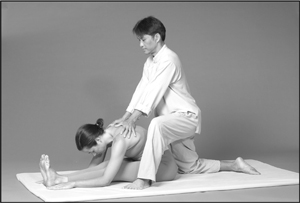
Forward bend
Characteristics of prana vayu: Energizing—inward movement, increasing vital energy; neutral temperature
Site: Head, moving down and in toward the throat, heart, lungs, and diaphragm
Prana vayu is increased by forward bends, inwardly directed postures, pranayama breathing exercises.
The movements most closely associated with activating prana vayu are forward bends, marma point pressure, and pranayama, or yogic breathing exercises, such as anuloma viloma (alternate nostril breathing). Forward-bending postures encourage the recipient to surrender and turn his attention inward. Postures that engage prana vayu tend to have a neutralizing effect on body temperature, thereby relieving excessive heat or cold. By closing off to outside distractions and excessive stimulation, the recipient experiences an inner recharging of his or her innermost vital essence. For this reason, prana vayu is most beneficial to vata types, who typically exhaust much of their energy by responding to external disturbances.
When working on vata clients, imagine that you are channeling the prana vayu to the center of the body to recharge the pranic battery. By regulating the prana vayu, we help our clients to conserve their energy reserves and avoid depleting their energy levels. This is especially important for vatas, who tend to have bursts of energy that become quickly frittered away, leaving them emotionally and physically exhausted.
Udana Vayu ↑ |
Best for: Kapha |
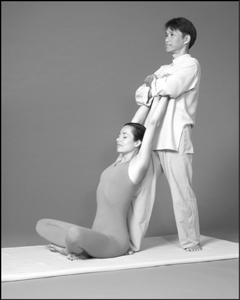
Udana stretch
Characteristics of udana vayu: Ascending movement; heating
Site: Diaphragm, moving up through the lungs and throat and up to the crown of the head
Udana vayu is increased by the dynamic movement of raising hands or legs, and by inverted postures.
Any movement that draws the recipient’s attention to the cranial region and area just above the head stimulates the upward flow of udana vayu. This includes poses with the extremities extended above the body, such as overhead arm stretches, leg raises, or inversions. The rush of blood to the upper extremities, head, face, and sensory organs tends to have a heating effect on the body. A good example of a Thai Yoga Massage posture that encourages upward movement is Udana Stretch. This upward surge of energy awakens the mind and senses, making it ideal for mobilizing stagnant kapha types. When working on kapha clients, the use of dynamic and aerobic movements can help to counter this body type’s slow and inert pace, opening the body and removing blockages. The breathing technique of kapalabhati, which involves a rapid succession of forcible expulsions through a pumping of the abdomen, also engages udana vayu.
Best for: Vata and kapha |
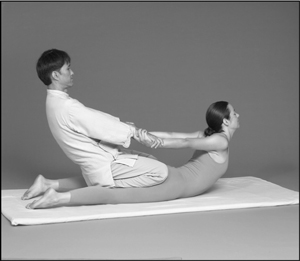
Cobra pose
Characteristics of vyana vayu: Expanding—outward movement; heating
Site: Heart, moving throughout the body to all extremities; promotes arterial and venous circulation
Vyana vayu is increased by backbends, extending poses, spinal twists, traction, rotations, palming, and thumbing.
The outward flow of vyana vayu mobilizes the blood to circulate oxygen and nutrients to all of the body’s extremities. Postures that generally increase vyana vayu include backbends, extensions, spinal twists, tractions, and rotations. For example, Cobra pose provides an upper backbend that stimulates the heart and increases arterial and venous circulation. Vyana vayu is also stimulated by the Thai Yoga Massage techniques of palming and thumbing, which increase circulation and waste removal within the bodily tissues. Working along the sen energy lines is particularly good for promoting an outward flow of blood from the heart, which washes away lactic acid buildup.
In general, all circular motions can be associated with vyana vayu, including the rhythmic rocking technique of whirlpool rock, which stimulates vyana vayu in the practitioner and receiver. (The rhythmic rocking techniques will be covered in chapter 5.) This vayu is also stimulated during the Thai Yoga Massage technique of blood stop on the arms and legs, which creates a rush of blood through the body. The outward and expanding distribution of blood has a heating effect on the body and for this reason is suitable for balancing the cooler doshas of vata and kapha.
Samana Vayu → ← |
Best for: Pitta and vata |
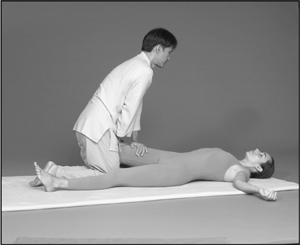
Demi Diamond
Characteristics of samana vayu: Contracting—consolidated, centralized, or introverted movement of digestion to balance agni (digestive fire); heating
Site: Small intestines, moving around the navel and out to the large intestines
Samana vayu is increased by sitting poses, bound postures, and mild spinal twists that tone the liver, spleen, and stomach.
Samana vayu is a contracting and centralized flow of energy that occurs around the navel in preparation for digestion and absorption. Samana vayu governs the secretion of liver enzymes, the proper functioning of the gall bladder, and the regulation of appetite. Postures that can be associated with activating this vayu include bound postures, mild spinal twists, and all sitting poses that promote stability such as the Demi Lotus and Demi Diamond. These movements help to activate samana vayu by consolidating the body’s energy and channeling it to the digestive fire of agni, which is responsible for maintaining proper metabolic balance.
The palming of organ reflex points during the abdominal massage is particularly good for promoting samana vayu and proper digestion. For example, the Thai Yoga Massage posture Demi Diamond enables an efficient channeling of digestive energy that has a cooling effect on the body. For this reason, postures that activate samana vayu are particularly suitable for pitta types.
Apana Vayu ↓ |
Best for: Vata and pitta |
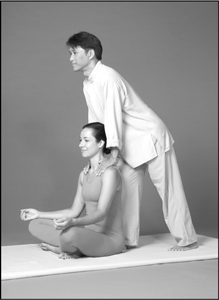
Palming Shoulders
Characteristics of apana vayu: Descending movement; cooling
Site: Colon, pelvic cavity, urinary tract, and reproductive organs, moving downward and outward
Apana is increased by comfortable sitting postures that stabilize the legs, lying postures, squatting, and downward movement of the abdomen.
Apana vayu is the downward and outward movement of the body that is responsible for eliminating waste products that exist on both the physical and mental levels. Sitting, squatting, and lying down postures promote relaxation and allow for waste to surface and be expelled from the body. Apana energy is activated while we sleep, which on the mental level is evident by the release of anxiety and negative thoughts in our dreams. On a physical level, apana vayu is present in the need to evacuate the bladder and bowels shortly after waking. Palming Shoulders stimulates a downward movement that follows the natural flow of gravity downward and out. Apana vayu is also associated with postures that release excess “wind,” or vata, in the body, such as Demi Lotus, a variation of the Wind-Relieving yoga asana. The well-loved Thai technique of toe cracking is another example of how excess wind is expelled from the body.
A well-balanced Thai Yoga Massage session or yoga practice will engage all five vayus: providing energization (prana), expansion (vyana), contraction (samana), upward movement (udana), and downward movement (apana). However, we can cater a session by channeling those vayus that are most appropriate for each constitutional type. As you integrate this knowledge into your practice, remember that the vayus are subtle energies that require a sensitive and meditative approach to practice. Mindful awareness and directed intention can increase the healing benefits of each vayu discussed.
The most important vayu to connect with for our light, airy, vata types is the grounding, downward movement of apana vayu. Vatas also tend to have erratic and weak energy levels and for that reason they benefit from the inwardly restorative effect of prana vayu. While working on a vata client, the one vayu you should avoid is the upward movement of udana, as this tends to “space out” and deplete vata. Samana and vyana are also beneficial for vata as the former stimulates digestion and the latter circulation, both areas of weakness for vata people.
Pitta recipients generally benefit from a cooling flow of samana vayu that pulls excess heat from the extremities inward toward the abdomen. Apana vayu is also good for pittas as it drains excess heat from the head and upper body and moves it to the lower extremities. Pittas should avoid postures that overly activate the heating vayus of udana and vyana.
Kapha practice should primarily focus on increasing the upward movement of udana to bring lightness, energy, and stimulation to the body. The most effective way to activate udana is through inverted postures and poses in which the recipient’s arms and legs are extended over her head. Postures that activate circulation through vyana vayu also benefit kapha. Kaphas should avoid forward bends, which contract the chest, and too many sitting and lying poses, which activate the stabilizing vayus of apana and samana.
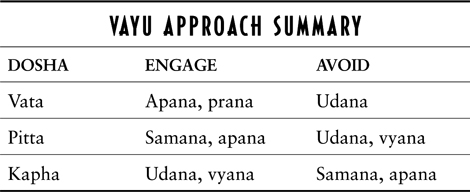
Perhaps the most effective method of connecting with the five vayus is to experience these subtle energies firsthand within your own body. The following meditation, based on the work of Dr. David Frawley, is a good means for exploring the vayus.
To practice this meditation, sit in a comfortable position, close your eyes, and listen to these words spoken by another person or by your own recorded voice.

Take a deep inhalation. Imagine the prana entering your nose and traveling inward, toward your cranial cavity and head. The movement of prana vayu continues downward and inward toward your throat, lungs, diaphragm, and heart. Prana vayu governs inhalation. Take a few deep breaths.
On your next inhalation, feel the prana moving from the diaphragm upward into the lungs, bronchi, throat, sinus cavity, and all the way up to the crown of your head. This is udana vayu; it is responsible for governing exhalation. With each exhalation notice a lifting sensation expanding upward through the body.
Inhale deeply, allowing the breath to expand into your belly. Feel the prana moving into your abdomen. As you continue to breathe into the abdomen, draw your attention to the linear movement around the navel, stomach, and small intestines. This is samana vayu. As you exhale, notice that the abdomen naturally contracts, releasing excess heat in the digestive region. With each inhale draw new energy to the region, enabling the secretion of enzymes and digestive juices for proper digestion and absorption.
Now draw your attention to your heart. On your next exhalation imagine the prana traveling from the heart and expanding outward to all the extremities of the body, extending into each and every finger and toe. This is vyana vayu. Continue to breathe deeply and more rapidly than normal. Feel a heating sensation as your breath circulates oxygen to all regions of the body.
Take a deep inhalation. As you exhale feel a downward sensation throughout the body, as if you are being pulled down with the natural force of gravity. This is apana vayu; it governs the body’s waste removal and reproductive system. On your next inhale draw your attention to your pelvic cavity, colon, urinary tract, rectum, and reproductive organs. Exhale and follow the breath downward and out, tracking the path of elimination for all food, water, and negative thinking.

In this chapter we have considered several techniques for customizing Thai Yoga Massage according to the Ayurvedic needs of our clients. We began with the three main massage approaches that can be applied to counterbalance the predominant constitution of our recipients. We also discussed the areas of accumulation in the body for each dosha. Finally, we introduced the concept of the kosha bodies and the vayus, which unveil the energetic potential within Thai Yoga Therapy.
In the following chapter, we conclude our discussion of massage approach by reflecting on energy-line work and marma point pressure for each dosha. Ideally, each of these techniques should be integrated into a massage practice in an intuitive way that does not follow a formulaic pattern. The Japanese samurai swordsmen learn their skills through a series of detailed exercises studied carefully, one at a time. After many years of training, they retire to the mountains to meditate until they have forgotten what they have learned. When the swordsmen return, they have so naturally integrated the knowledge into their style that they are directed by intuition rather than thought.
Just like the swordsmen, we too need to begin by learning the precise techniques of customizing a massage according to Ayurvedic principles. Once we have integrated this knowledge into our style, we can abandon the specific details and let intuition guide us.